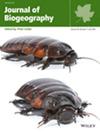Geographic Variation in Acoustic Signals in Wildlife: A Systematic Review
Abstract
Aim
Our main aim is to understand the geographic variation of acoustic signals in wildlife, its spatial, temporal and taxonomic extent, the methodological approaches used in the scientific literature, and the main drivers of geographic variation. Also, specifically for birds, we aim to understand the effect of learning behaviour and vocalisation type (i.e., call vs. song) on the geographic variability of their acoustic traits.
Location
Worldwide.
Methods
We performed a systematic literature review and identified 306 peer-reviewed articles covering geographic variation in animal acoustic signals.
Results
The studies were carried out in 93 countries, but most of them focussed on northern temperate areas and on a single country. The articles used mainly birds as study models (53.6%), followed by mammals (27.8%), anurans (10.5%), insects (7.2%), fishes (0.7%) and reptiles (0.3%). Most articles studied the existence of geographic variation among populations by comparing differences in signal features, such as frequency, duration or a combination of several signal features through ordination methods. The proportion of case studies (i.e., comparisons of different acoustic traits, with some studies including more than one comparison) finding geographic variation in acoustic signals was quite similar among all taxonomic groups (range 75.2%–82.7%) but differed between males and females (80.7% vs. 60.0%, respectively). We also identified a higher proportion of case studies finding acoustic differences among geographic regions when using as response variable multiple signal features (i.e., through ordination axes), followed by the use of acoustic signal type (i.e., categorical classification) or frequency. Besides, 69.7% of the case studies that assessed the relationship between acoustic similarity and geographic distance found a negative and significant pattern among these variables, while this was true only for 60.0% and 66.7% of the case studies assessing the relationship between acoustic similarity with genetic distance and ecological variables, respectively. Finally, when focussing on birds, there was a higher probability of finding geographic differences when using songs (84.2%) as the target vocalisation than when using calls (78.3%) and when considering as target species acoustic learners (83.4%) than when focussing on nonlearners (78.0%).
Main Conclusions
Overall, our review shows that our current knowledge of geographic variation in wildlife is biased towards birds from northern temperate areas and that most monitored wildlife populations differ in their acoustic traits to some extent, which is more often related to geographic distance than to genetic distance.


 求助内容:
求助内容: 应助结果提醒方式:
应助结果提醒方式:


